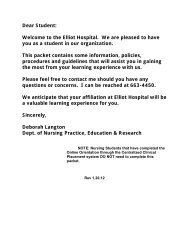VCUG Preparation Book - Elliot Hospital
VCUG Preparation Book - Elliot Hospital
VCUG Preparation Book - Elliot Hospital
Create successful ePaper yourself
Turn your PDF publications into a flip-book with our unique Google optimized e-Paper software.
<strong>VCUG</strong> <strong>Preparation</strong> <strong>Book</strong><br />
Voiding CYSTOURETHROGRAM
Hi There!<br />
Today you will be having a test done called a <strong>VCUG</strong>. A <strong>VCUG</strong> is a special way for the<br />
doctor to find out how your body is working. This book will help you to understand<br />
what to expect during your visit to the hospital. We understand that you may be a<br />
little scared, but your doctor, nurses, and child life specialist are here to answer all<br />
of your questions. Maybe you will even have a little bit of fun! Please let us know if<br />
you have any questions at all <br />
Sincerely,<br />
Your doctor, nurse, and child life specialist
Getting a <strong>VCUG</strong><br />
The best way to explain this is to go step by step. If<br />
something is going to be a little different when you<br />
come in for your <strong>VCUG</strong>, the nurse or child life<br />
specialist will explain it to you. As you read this with<br />
your parents, write down any questions you have.<br />
Bring your questions to the hospital and we’ll be sure<br />
to answer them all before we start.
Your parent can stay with you the whole<br />
time. You may also bring a special toy<br />
like a teddy bear, doll, or blanket to<br />
hold during the <strong>VCUG</strong><br />
* Note to parents- Women who are<br />
pregnant will not be permitted in the room<br />
where the X-Rays are taken.
Getting Vitals<br />
The nurse needs to make sure you are healthy and ready for the<br />
procedure. They do this by checking your Vitals.<br />
The nurse will take your temperature,<br />
your blood pressure (which feels like a hug on your<br />
arm),<br />
and your weight and pulse.
The nurse will ask girls to place their legs in the frog leg or butterfly position.<br />
To do this, bend your knees and put your feet close to your bottom,<br />
then lower your knees out to the side. It seems kind of silly, but it will<br />
only be for a few minutes. Boys will be asked to keep their legs straight.<br />
Some kids like to practice this at home<br />
before coming to the hospital.<br />
Do you think it looks more like a butterfly or frog<br />
getting ready to hop?
The nurse will then clean the private area<br />
between your legs with some<br />
brown soapy liquid. It may feel cold and wet.<br />
This makes the area extra clean. It’s<br />
important not to touch anything below your<br />
belly button after they clean this area, until<br />
the end of the test.
Next, the nurse will slide a tiny, flexible tube called a<br />
CATHETER along the path that your URINE (pee)<br />
takes from your bladder to the outside of your body.<br />
The nurse will loosely tape it to your leg so it doesn’t<br />
come out until after your pictures are all done.<br />
Putting the catheter in may feel uncomfortable, but it<br />
helps to try to relax your muscles as much as possible.<br />
You might be wondering how you would be able to relax<br />
during your <strong>VCUG</strong>. We’ve listed a few ideas on the next<br />
page that might help. Practice these things, maybe<br />
while you are lying flat or in the frog leg position. See<br />
which one makes you feel more relaxed.
Ideas for Relaxing During <strong>VCUG</strong><br />
1. Blowing bubbles: slowly take a deep breath in, and then very slowly<br />
pretend you are blowing a really big bubble. Go slowly, you don’t want<br />
the bubble to pop! You may need to pretend to blow more than one<br />
bubble while the nurse puts in the catheter.<br />
2. Singing: Practice singing some of your favorite songs…don’t leave out<br />
any of the words!<br />
3. Reading: Bring a book you really love, have Mom or Dad read it to you<br />
(or read it to them!) during the test. Other kids have said I Spy books<br />
are also very helpful.<br />
You might have your own ideas for helping yourself through this test. Let<br />
us know your ideas, we will try to do whatever we can to help. We<br />
realize this is new and different and maybe a little scary. Let us know<br />
how you are feeling. We think it’s ok to cry, too.
Helping the Nurse<br />
One thing you can do to help us during the<br />
test is to try to stay very still when the nurse<br />
is putting the catheter in, and when the<br />
pictures are being taken. The nurse, doctor,<br />
or technician will let you know when it’s most<br />
important for you to stay still.
When you are ready and it is your turn, the nurse<br />
will bring you and your parent to a room with a few<br />
big machines and a bed. These machines are just big<br />
cameras that take the special pictures! The cameras<br />
are connected to a TV screen so that the doctor can<br />
see the pictures as they are being taken.
You might notice some clear liquid hanging<br />
on a pole. You might hear them call the<br />
clear liquid CONTRAST. This liquid will<br />
help the x-ray pictures be clear.
Time to take the pictures…<br />
The liquid or contrast will be put through that tiny<br />
tube and might make you feel like you have to go pee.<br />
Try to wait as long as you can and then tell the nurse<br />
when you can’t hold it anymore.<br />
The nurse will then ask you to let the liquid come out.<br />
It may feel like you are peeing, but remember it is<br />
just the liquid coming out and there will be towels<br />
under you to keep you dry. The nurse will tell you<br />
when it is important to stay very still so the pictures<br />
come out clear.
Once the pictures are all done, you will<br />
be able to get dressed and go home!<br />
Make sure to write down any questions<br />
you have before coming to the hospital<br />
and we will be sure to answer them!
Questions to Bring to the <strong>Hospital</strong>
This book was created by the Child Life Program<br />
at New Hampshire’s <strong>Hospital</strong> for Children.<br />
To contact Child Life please call the office at:<br />
(603) 663-3416<br />
or e-mail us at:<br />
lfolger@elliot-hs.org<br />
Monday-Friday 8am-7pm









